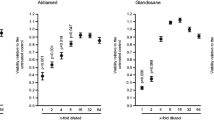Abstract
Purpose. To investigate the permeability and localization of topically applied 125I-TGF-β3 in porcine floor-of-mouth mucosa as a function of concentration and exposure.
Methods. The 125I-TGF-β3 diluted in three different vehicles was applied to the tissue samples mounted in perfusion cells maintained at 37°C. Flux and Kp values were calculated from the perfusate collected over a 24 hour period. The quantity of 125I-TGF-β3 present in the tissue was determined by horizontal sectioning and subsequent counting. The stability of 125I-TGF-β3 in saliva and in the tissue was analyzed by SDS polyacrylamide gradient gel electrophoresis.
Results. 125I-TGF-β3 was relatively stable in saliva and in the epithelium; approximately 50% of the total counts in the deeper epithelium were resident in the 25kDa TGF-β3 homodimer. A steady-state flux was reached ∼6 hours post application and Kp value was 4.0 ± 0.6 × 10-6 (mean ± sem). Penetration of 125I-TGF-β3 to the basal cell layer was concentration dependent but reached nanomolar concentrations even after extensive surface rinsing, representing over one-thousand fold the IC50 for epithelial cell cycle arrest.
Conclusions. The data suggest that topical application of TGF-β3 to the oral mucosa in an appropriate vehicle can provide effective therapeutic delivery to the tissue.
Similar content being viewed by others
REFERENCES
C. A. Squier. The permeability of oral mucosa. Crit. Rev. Oral Biol. Med. 2:13–32 (1991).
D. Harris and J. R. Robinson. Drug delivery via the mucous membranes of the oral cavity J. Pharm. Sci. 81:1–10 (1992).
P. W. Wertz, J. Hoogstraate, and C. A. Squier. Biochemical Basis of the Permeability Barrier in Skin and Oral Mucosa. In M. J. Rathbone (eds), Oral Mucosal Drug Delivery, Marcel Dekker Inc, New York, 1996, pp. 27–49.
C. A. Squier and P. W. Wertz. Structure and Function of Oral Mucosa and Implications for Drug Delivery. In M. J. Rathbone (eds), Oral Mucosal Drug Delivery, Marcel Dekker Inc, New York, 1996, pp. 1–26.
P. W. Wertz and C. A. Squier. Cellular and molecular basis of barrier function in oral epithelium. Crit. Rev. Ther. Drug Carrier Syst. 8:237–269 (1991).
P. Collins, J. E. Laffoon, and C. A. Squier. Comparative structure of porcine oral epithelia. J. Dent. Res. 60:543 (1981).
C. A. Lesch, C. A. Squier, A. Cruchley, D. M. Williams, and P. Speight. The permeability of human oral mucosa and skin to water. J. Dent. Res. 68:1345–1349 (1989).
C. A. Squier. Oral complications of cancer therapies. Mucosal alterations. NCl Monogr. 9:169–172 (1990).
S. T. Sonis. Oral Complications of Cancer Chemotherapy. In V. T. DeVita, Jr., S. Hellman and S. A. Rosenberg (eds), Cancer. Principles and Practice of Oncology, Lippincott, Philadelphia, 1993, pp. 2385–2394.
S. T. Sonis, L. Lindquist, A. G. Van Vugt, A. A. Stewart, K. Stam, G. Y. Qu, K. K. Iwata, and J. D. Haley. Prevention of chemotherapy-induced ulcerative mucositis by transforming growth factor beta 3. Cancer Res. 54:1135–1138 (1994).
S. T. Sonis, A. G. Van Vugt, J. P. O'Brien, A. D. Muska, A. M. Bruskin, A. Rose, and J. D. Haley. Transforming growth factor-beta 3 mediated modulation of cell cycling and attenuation of 5-fluorouracil induced oral mucositis. Oral Oncol. 33:47–54 (1997).
C. S. Potten, D. Booth, and J. D. Haley. Pretreatment with transforming growth factor beta-3 protects small intestinal stem cells against radiation damage in vivo. Br. J. Cancer 75:1454–1459 (1997).
A. B. Roberts and M. B. Sporn. The Transforming Growth Factor-βs. In M. B. Sporn and A. B. Roberts (eds), Peptide Growth Factors and Their Receptors I, Springer-Verlag, New York, 1991, pp. 419–472.
A. A. Stewart, J. D. Haley, G. Y. Qu, K. Stam, D. Fenyo, B. T. Chait, D. R. Marshak, A. Y. Ng, G. Marley, and K. K. Iwata. Umbilical cord transforming growth factor-β3: isolation, comparison with recombinant TGF-β3 and cellular localization. Growth Factors 13:87–98 (1996).
D. A. Cox. Transforming growth factor-beta 3. Cell Biol. Int. 19:357–371 (1995).
N. Cerletti, G. K. McMaster, A. Schitz, and D. Cox. Preparation of biologically active TGF-β2 by in vitro folding of the monomeric protein expressed in E. coli. Protein Sci. 2(Suppl 1):62 (1993).
M. P. Schlunegger, N. Cerletti, D. A. Cox, G. K. McMaster, A. Schmitz, and M. G. Grutter. Crystallization and preliminary x-ray analysis of recombinant human transforming growth factor beta-2. FEBS Lett. 303:91–93 (1992).
K. K. Iwata, C. C. Fryling, W. B. Knott, and G. J. Todaro. Isolation of tumor cell growth-inhibiting factors from a human rhabdomyosarcoma cell line. Cancer Res. 45:2689–2694 (1985).
C. A. Squier, M. Kremer, and P. W. Wertz. Continuous flow mucosal cells for measuring the in-vitro permeability of small tissue samples. J. Pharm. Sci. 86:82–84 (1997).
P. Cox and C. A. Squier. Variations in lipids in different layers of porcine epidermis. J. Invest. Dermatol. 87:741–744 (1986).
C. A. Squier and C. A. Lesch. Penetration pathways of different compounds through epidermis and oral epithelia. J. Oral Pathol. 17:512–516 (1988).
P. W. Wertz, D. C. Swartzendruber, and C. A. Squier. Regional variation in the structure and permeability of oral mucosa and skin. Adv. Drug Del. Rev. 12:1–12 (1993).
N. F. Ho. Biophysical kinetic modeling of buccal absorption. Adv. Drug Del. Rev. 12:61–98 (1993).
X. Du, M. Kremer, P. W. Wertz, and C. A. Squier. Oral epithelial flux and reservoir function following brief exposure to ethanol. J. Dent. Res. 76: 362 (1997).
M. J. Kremer, C. A. Squier, and P. W. Wertz. Absorption and release of topical triamcinolone in oral mucosa. J. Dent. Res. 76:361 (1997).
S. Law, P. W. Wertz, D. C. Swartzendruber, and C. A. Squier. Regional variation in content, composition and organization of porcine epithelial barrier lipids revealed by thin-layer chromatography and transmission electron microscopy. Arch. Oral Biol. 40:1085–1091 (1995).
Author information
Authors and Affiliations
Corresponding author
Rights and permissions
About this article
Cite this article
Squier, C.A., Kremer, M.J., Bruskin, A. et al. Oral Mucosal Permeability and Stability of Transforming Growth Factor Beta-3 In Vitro . Pharm Res 16, 1557–1563 (1999). https://doi.org/10.1023/A:1015052520467
Issue Date:
DOI: https://doi.org/10.1023/A:1015052520467




